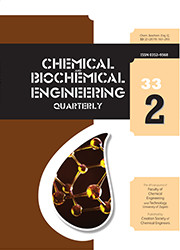The aim of this study was to investigate the removal of estrogen hormones (17β-estradiol and estrone) from aqueous solutions using rice husk extracted silica. Rice husk was collected from rice factories in Mazandaran province (Iran) and the adsorbent was prepared in a furnace at 800 °C for 4 h, after acid leaching with hydrochloric and sulfuric acid mixture. Optimal operating parameters for estrogen removal were determined, including initial pH values (4–9), adsorbent dosages (0.5, 1, 1.5, and 2 g L–1), contact times (30, 60, 90, and 120 min), and initial concentrations of 17β-estradiol and estrone (10, 40, 70 and 100 ng L–1); one-factor-at-a-time method was used. The method of electrochemiluminescence was used to measure the concentration of hormones. Kinetic adsorption models and adsorption isotherms were also studied. The maximum removal efficiency (%) of 17β-estradiol (E2) and estrone (E1) hormones of 95.5 and 93.1 %, respectively, was obtained at optimal conditions of pH 4, 1.5 g L–1 of adsorbent dosage, 60 min of contact time and 10 ng L–1 initial concentrations of E2 and E1. Pseudo first-order kinetic model and Langmuir adsorption isotherm had the best fit with experimental data for both estrogen hormones, following nonlinear regression procedure. Rice husk silica could be considered as effective and accessible adsorbent for removal of estrogenic hormones.
Sažetak
Dio od

 Chemical & biochemical engineering quarterly : the international publication of "Kemija u industriji" : the official journal of Croatian Society of Chemical Engineers, Faculty of Chemical Engineering and Technology University of Zagreb, Slovenian Chemical Society, and Austrian Association of Bioprocess Technology : 33,2(2019) / Co-Editors-in Chief: M. Rogošić, B. Zelić.
Chemical & biochemical engineering quarterly : the international publication of "Kemija u industriji" : the official journal of Croatian Society of Chemical Engineers, Faculty of Chemical Engineering and Technology University of Zagreb, Slovenian Chemical Society, and Austrian Association of Bioprocess Technology : 33,2(2019) / Co-Editors-in Chief: M. Rogošić, B. Zelić.